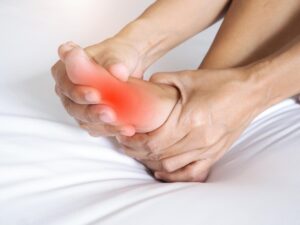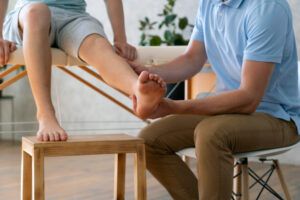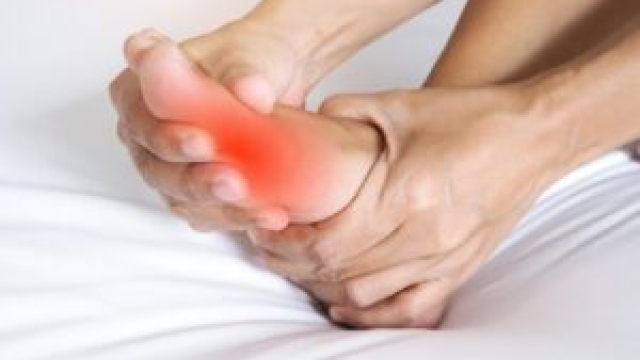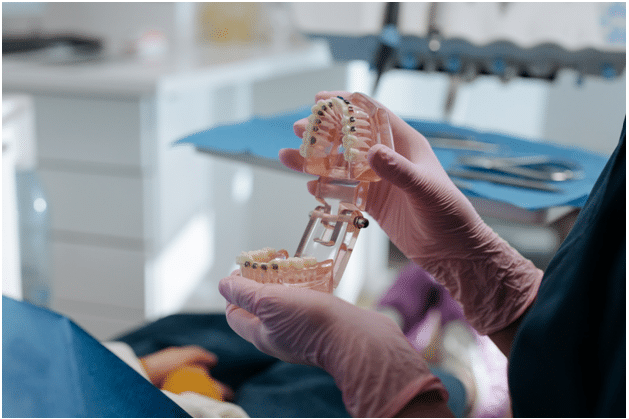Introduction:
Bunions, those bony protrusions at the base of the big toe, can be more than just a cosmetic concern; they often bring pain and discomfort. If you’re one of the millions seeking relief from bunion pain, you’ve come to the right place. In this comprehensive guide, we’ll explore the causes of bunions, their symptoms, and most importantly, effective strategies for bunion pain relief.

Understanding Bunions:
Causes of Bunions:
Bunions, medically known as hallux valgus, typically develop due to:
Genetics:
- Family history plays a significant role. If bunions run in your family, you may be genetically predisposed.
Foot Structure:
- Flat feet or low arches can contribute to the development of bunions.
Improper Footwear:
- Wearing tight, narrow, or high-heeled shoes can force the big toe to lean toward the second toe, causing a bunion.
Medical Conditions:
- Certain conditions, like arthritis, can increase the likelihood of developing bunions.
Occupational Factors:
- Certain occupations that involve prolonged standing or walking may contribute to bunion development.
Symptoms of Bunion Pain:
Identifying bunion pain is crucial. Symptoms may include:
Pain and Soreness:
- Persistent pain around the big toe joint, especially during walking or wearing shoes.
Swelling and Inflammation:
- Swelling and redness at the base of the big toe.
Limited Toe Movement:
- Difficulty in moving the big toe, particularly when trying to push off while walking.
Corns and Calluses:
- Corns or calluses may form due to friction between the bunion and footwear.
Footworks Podiatry’s Approach to Bunion Pain Relief
Footworks Podiatry, a trusted name in foot care, takes a personalized and holistic approach to bunion pain relief. Let’s explore the strategies employed by their expert podiatrists:
Comprehensive Evaluation:
- Each patient undergoes a thorough examination to understand the severity of the bunion and any underlying factors contributing to the pain.
Footwear Recommendations:
- Footworks Podiatry provides guidance on footwear choices, emphasizing the importance of comfortable, supportive shoes that accommodate the bunion.
Orthotic Inserts:
- Custom orthotic inserts are designed to provide additional support, improve foot alignment, and alleviate pressure on the bunion.
Physical Therapy:
- Tailored exercises and stretches help strengthen the foot muscles, improving overall foot function and reducing bunion pain.
Anti-Inflammatory Treatments:
- When appropriate, Footworks Podiatry may recommend anti-inflammatory medications or topical treatments to manage pain and swelling.
Bunion Padding and Taping:
- Specialized padding and taping techniques can help redistribute pressure away from the bunion, providing relief.
Minimally Invasive Procedures:
- For more severe cases, Footworks Podiatry offers minimally invasive procedures to realign the toe joint and alleviate bunion pain.
Part 1: At-Home Remedies for Bunion Pain Relief
Proper Footwear:
One of the most crucial steps in non surgical bunion treatment is making wise footwear choices:
- Opt for shoes with a wide toe box to accommodate the bunion.
- Choose styles with good arch support to distribute pressure evenly.
Toe Spacers and Orthotic Inserts:
Toe spacers can help maintain proper toe alignment and relieve pressure on the bunion. Additionally, custom orthotic inserts can provide additional support and cushioning.
Warm Soaks and Ice Packs:
Alternating between warm soaks and ice packs can help alleviate pain and reduce inflammation. Warm water soothes, while ice packs numb the area.
Toe Exercises and Stretches:
Gentle exercises and stretches can improve flexibility and strengthen the muscles around the bunion. Consult a healthcare professional for guidance on suitable exercises.
Over-the-Counter Pain Relievers:
Non-prescription pain relievers like ibuprofen or acetaminophen can temporarily alleviate bunion pain. However, consult with a healthcare professional before using them regularly.
Part 2: Professional Bunion Pain Relief Strategies
When seeking bunion pain relief, professional strategies offered by experts like Footworks Podiatry make a significant impact. These specialists employ personalized approaches, starting with a thorough examination to assess the severity of the bunion. Custom orthotic inserts, designed to address specific foot issues, are often prescribed to improve foot mechanics and alleviate pain.

Physical therapy sessions, bunion padding, and taping techniques further contribute to comprehensive relief. For severe cases, minimally invasive procedures are available, aiming to realign the toe joint. Trusting in professional bunion pain relief strategies ensures a targeted and effective path to comfort.
Consult a Podiatrist:
For a comprehensive approach to bunion pain relief, consider consulting a podiatrist. They can provide a thorough examination, assess the severity of the bunion, and recommend personalized treatment options.
Custom Orthotics:
Podiatrists often prescribe custom orthotic inserts designed to address specific foot issues, including bunions. These inserts can help improve foot mechanics and alleviate bunion pain.
Physical Therapy:
Physical therapy sessions may include targeted exercises to strengthen foot muscles, improve flexibility, and enhance overall foot function. A physical therapist can guide you through a tailored program.
Bunion Padding and Taping:
Specialized padding and taping techniques can be employed to reduce friction and redistribute pressure away from the bunion, providing relief.
Minimally Invasive Procedures:
For severe cases where conservative measures are insufficient, minimally invasive procedures may be considered. These procedures aim to realign the toe joint and alleviate bunion pain.
Part 3: Long-Term Strategies for Bunion Pain Management
Foot Health Awareness:
Regular foot check-ups and awareness of any changes or discomfort are essential. Detecting issues early allows for proactive intervention.
Maintaining a Healthy Weight:
Excess body weight can contribute to bunion development and exacerbate existing pain. Maintaining a healthy weight can reduce the strain on the feet.
Proper Shoe Fit:
Continue to prioritize proper footwear. Avoid shoes that squeeze or put excessive pressure on the toes. Regularly reassess your shoe size, especially if there are any changes in foot structure.
Stay Active with Low-Impact Exercises:
Engage in low-impact exercises such as swimming or cycling to stay active without putting undue stress on the feet.
Conclusion:
Bunion pain relief is a journey that involves a combination of at-home remedies, professional interventions, and long-term lifestyle adjustments. While the strategies outlined here can provide relief, it’s crucial to recognize that individual responses may vary.
Footworks Podiatry, with its commitment to personalized care and expertise, stands as a reliable partner in your quest for bunion pain relief. Their podiatrists offer a holistic approach, addressing the root causes of bunion pain and providing tailored solutions for each patient.
Remember, a pain-free life is within reach. By understanding the causes, recognizing symptoms, and exploring effective relief strategies, you can take confident steps towards a future free from the constraints of bunion discomfort. Trust Footworks Podiatry to guide you on this journey, providing relief and paving the way for a future of pain-free walking.




